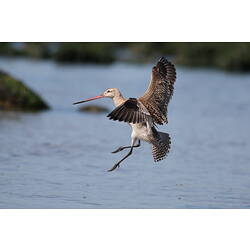General Description
Bar-tailed Godwits change colour between the breeding and non-breeding seasons. In Australia, they are usually in their non-breeding plumage where the upper body parts are brownish-grey with narrow black and white streaks, and the underparts are grey and white with fine dark streaks and arrowheads. The breeding plumage becomes reddish brown. The bill is long, slightly upturned and two-coloured - the first half (from the base) is pink and the half towards the tip is grey. Bill to tail length is up to 45 cm.
Biology
Bar-tailed Godwits breed at sites in Scandinavia, Russia and Alaska during the Northern Hemisphere summer then migrate southwards. Some birds come to Australia and New Zealand, arriving here from late August. Godwits have been recorded making the 11,000 km journey from Alaska to New Zealand non-stop in nine days. The subspecies Limosa lapponica baueri includes birds that breed in Alaska and migrate to Victoria. This subspecies is now listed by the Australian government as being vulnerable to extinction. In Australia, godwits spend their time resting and feeding. They feed in shallow water or at the water's edge, probing their bill into the sand or mud to locate food. They eat worms, molluscs and small crustaceans as well as some plant material. Godwits usually begin their migration back to the Northern Hemisphere in March or April. They face threats from habitat destruction along their migration routes and in Australia.
Distribution
Global distribution with some birds migrating between the Northern and Southern Hemisphere. In Australia, the birds are found in eastern and north-western mainland Australia and Tasmania.
Habitat
Found on coastal mudflats, and occasionally on inland lakes.
More Information
-
Animal Type
-
Animal SubType
-
Brief Id
One of the larger migratory shorebirds. Bar-tailed Godwits are mottled brown and have a very long, slightly upturned pink and grey bill.
-
Colours
Brown, White
-
Maximum Size
45 cm
-
Habitats
-
Diet
Carnivore
-
Diet Categories
Invertebrates, Insects
-
Endemicity
-
Conservation Statuses
CITES: Not listed, FFG Threatened List: Vulnerable, IUCN Red List: Near Threatened
-
Taxon Name
-
Common Name
Bar-tailed Godwit
-
Kingdom
-
Phylum
-
Subphylum
-
Class
-
Order
-
Family
-
Genus
-
Species Name
lapponica



